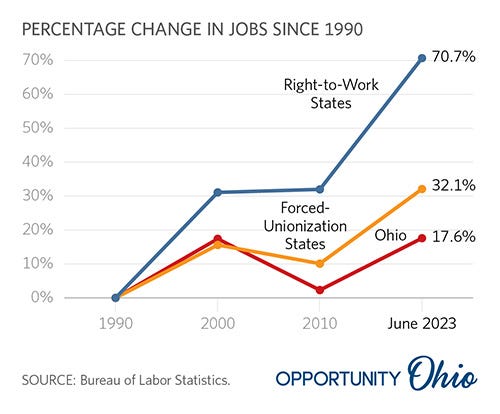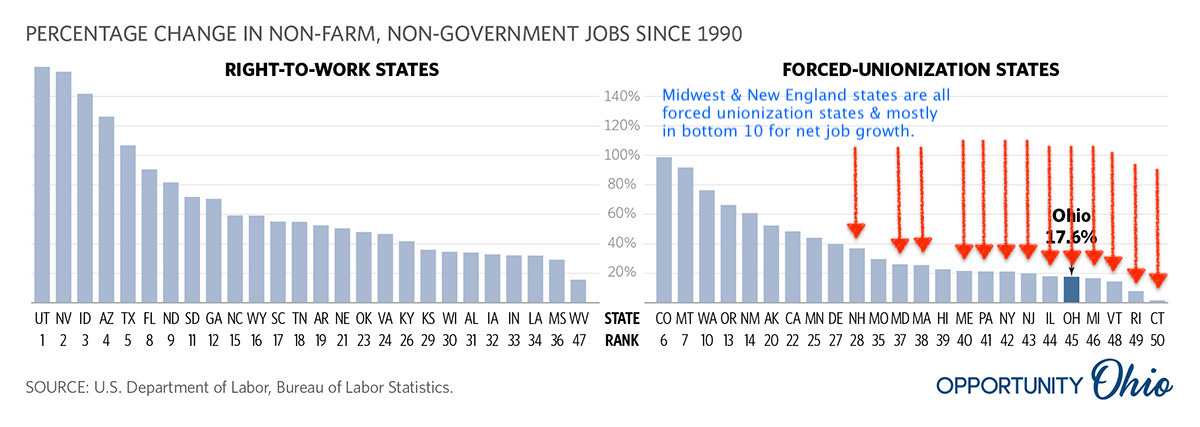Don’t Waste Your Hard-Earned Money Joining the Grossly Ineffective Ohio Chamber of Commerce
The OCC has become little more than an Establishment group pushing pale pastel policies that do little to truly impact Ohio’s economic and business climate.
Over the last few weeks, I’ve received at least three emails from Ohio Chamber of Commerce (OCC) CEO Steve Stivers asking me to join his new entity, the Ohio Chamber Action Network. To join, you have to give the OCC $125.00. Steve says he’s "on a new mission, to create a growing and prosperous economic and business climate in the great state of Ohio.” New mission? Hasn’t or shouldn’t that always have been the mission of the OCC? Nevertheless, I applaud Steve and the OCC for this “new” mission. Unfortunately, history shows the OCC, along with its political partners in the Ohio General Assembly, Governor’s Office, and JobsOhio, is utterly ineffective at creating a growing and prosperous economic business climate in Ohio.
I won’t bore you by rehashing the data and the charts from what I wrote a month ago in the piece, “Why Is It So Hard for Politicians to Shoot Straight with Ohioans About Our Systemically Underperforming Jobs Economy?,” as you can read it at the link if you missed it. The punchline is that Ohio’s private sector consistently has been at the back of the pack for over two decades, with one of the weakest pandemic shutdown recoveries (39th) and one of the slowest states to get back to the March 2000 jobs peak (49th). Even worse, outside of the Greater Cincinnati and Columbus areas, most of Ohio’s counties are hollowing out as people and jobs decline. Had the OCC succeeded at its core job over the last twenty-three years, those numbers would look radically different. Instead of acknowledging its failure and changing its policy priorities, the OCC simply doubles down by asking you to fund more of the same.
As to its policy priorities, did you know that among its top ten priorities “to create a growing and prosperous economic and business climate” are (1) creating a certified mental health assistant program and (2) expanding Medicaid even more than Ohio already has done to cover those 65 years old and over. I bet you didn’t realize that one of the greatest obstacles to Ohio moving from the bottom of the rankings to the top is not having a certified mental health assistant program. Similarly, after adding 1.1 million people to Medicaid via John Kasich’s expansion under Obamacare, Ohio employers are suffering because they can’t push more of their health care costs onto you by shifting older and expensive workers to Medicaid. You can review the full list here, but notice what is NOT on the list—enacting right-to-work, eliminating the state income tax, or any policy on preventing illegal immigrants from undermining Ohio’s legal workforce (e.g., requiring all employers to use the E-Verify system on employees like Florida requires).
After getting the first email from Steve, I sent a response to him asking him to let me know where he and the OCC stand on some core issues. Not surprisingly, he did not respond. Here are a few policies that I noted are key based on the unequivocal data to moving Ohio into the top ten in net percentage private sector job growth:
Enact right-to-work;
Eliminate the state income tax;
Repeal Medicaid expansion under Obamacare;
Truly dig into state government to get rid of regulations that carry a cost greater than any benefits derived;
Eliminate JobsOhio and use funds to build a world-class airport to make it easier for Ohioans and their business to travel and to make Ohio more attractive to non-Ohio businesses;
Leverage Ohio’s natural energy resources to insure businesses and consumers have access to low-cost, plentiful energy;
Rebalance our investments in higher education versus tech/trade so that more of Ohio’s high school graduates get the training they need for the 21st century; and
Fight aggressively to keep Ohio jobs for Ohioans and those in America legally
The OCC won’t touch most of these policies, but will provide lots of excuses on why those policies aren’t really needed. Take right-to-work. The former CEO of the OCC, Andy Doehrel, told me over a decade ago that the OCC wouldn’t support right-to-work, as it wasn’t needed in Ohio. One can ignore the shift of tire manufacturing from Ohio to right-to-work states since 2000, or the movement of airplane manufacturing to right-to-work states, or the movement of traditional auto manufacturing to right-to-work states, or the fact that 83% of electric vehicle facilities are being built in right-to-work states, but what one cannot ignore is the long-term, unequivocal data on job growth since 1990. As the chart below shows, no matter the industry, if you want “to create a growing and prosperous economic and business climate,” you stand a far, far better chance of doing so in a right-to-work state (70.7% net average growth) than a forced unionization state (32.1% net average growth—less than half that of right-to-work states). With all of those jobs in right-to-work states go the people and their tax dollars, which is why Ohio’s population has remained stagnant over the last twenty-years (up 0.2% per year), why we’ve lost nearly 700,000 Ohioans ages 10 to 54 (i.e., our prime upcoming and current workforce), and why we've lost billions in adjusted gross income, as more people left Ohio for greener pastures than came.
I also believe right-to-work serves as the “indicator species” of a pro-prosperity mindset and fundamental evidence of political courage. Remember when the Left used the Spotted Owl as the indicator species of a forest’s decline due to clearcut logging. The decline of the Spotted Owl indicated the overall decline in the health of the forest. Right-to-work is the Spotted Owl of a healthy economy, as it shows the mindset of policymakers as pro-prosperity warriors. If policymakers won’t support or fight for right-to-work, you can be certain they also won’t support or fight for eliminating the state income tax, repealing Medicaid expansion under Obamacare, ending the feckless JobsOhio, and the other bold color policies Ohio needs to excel. It takes real political courage to fight the big, consequential battles needed for a “blue" policy state like Ohio to be revitalized. Without pro-prosperity warrior policymakers willing to fight for Main Street Ohioans, Ohio will remain a dead state walking like the rest of the Midwest and New England states.
If Steve and the OCC adopted the above agenda, then I’d be the first to join their group. Unfortunately, he and they won’t. Thus, I’d strongly suggest you decline Steve’s invitation to send your hard-earned money to a group that hasn’t had any measurable success in improving Ohio’s economic and business climate LITERALLY IN DECADES. The OCC has become little more than an Establishment group pushing pale pastel policies that do little to truly impact Ohio’s economic and business climate. If you want to make a charitable, tax deductible gift to a group fighting to get the changes above enacted, then please consider supporting our vital work and donating to Opportunity Ohio, which has been alone in the trenches over the last twelve years fighting the Establishment’s pale pastel agenda and pushing bold color policies without the help of groups that should be natural allies like the OCC. To donate, you can click on this link, or send a check to: Opportunity Ohio, P.O. Box 98, Dublin, Ohio 43017-0098.
P.S. As you may have noticed, I’ve not been on the Bruce Hooley Show on The Answer the last few weeks. Unfortunately, Bruce was diagnosed with brain cancer so is getting treatment. Please keep Bruce and his family in your prayers. With God’s grace, Bruce will be back in the radio studio soon.








Jobsohio is/was a member of the World Economic Forum along with some other companies like Honda. The WEF agenda is not for the good of the people. We the people of Ohio have been sold out on many levels.
I enjoy reading your post. Thanks